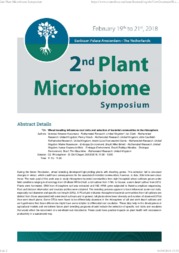Wheat breeding influences root traits and selection of bacterial communities in the rhizosphere.
Wheat breeding influences root traits and selection of bacterial communities in the rhizosphere.
Author(s): KAVAMURA, V. N.; CLARK, I.; HIRSCH, P. R.; CAULFIELD, J.; SARRIA, A. F.; ROSSMANN, M.; BIRKETT, M.; MELO, I. S. de; MENDES, R.; MAUCHLINE, T.
Summary: During the Green Revolution, wheat breeding developed high-yielding plants with dwarfing genes. This selection led to structural changes in wheat, which could have consequences for the associated microbial communities, however, to date, little is known about these. The main goal of this work was to study rhizosphere bacterial communities from eight hexaploid wheat cultivars grown under field conditions ranging in chronology from Chidham White Chaff, a tall cultivar from 1790, to Crusoe, a semi dwarf cultivar from 2012. Plants were harvested, DNA from rhizosphere soil was extracted and 16S rRNA gene subjected to Illumina amplicon sequencing. Root architecture information and exudate profiles were obtained. The breeding process appears to have influenced some root traits, especially root diameter and specific root length (SRL). A PCoA plot indicates rhizosphere bacterial communities from tall cultivars are distinct from those associated with semi dwarf cultivars and in general, tall plants show lower diversity and number of observed OTUs than semi dwarf plants. Some OTUs were found to be differentially abundant in the rhizosphere of tall and semi dwarf cultivars and we hypothesize that these differences might have some relation to differential root exudation. These data help in the development of agricultural models and we believe future plant breeding programs should include the selection of specific root traits and exudates that would affect the recruitment of a beneficial root microbiome. These could have positive impacts on plant health with increases in productivity in a sustainable way.
Publication year: 2018
Types of publication: Abstract in annals or event proceedings
Unit: Embrapa Environment
Keywords: Rhizosphere, Roots, Wheat
Observation
Some of Embrapa's publications are published as ePub files. To read them, use or download one of the following free software options to your computer or mobile device. Android: Google Play Books; IOS: iBooks; Windows and Linux: Calibre.
Access other publications
Access the Agricultural Research Database (BDPA) to consult Embrapa's full library collection and records.
Visit Embrapa Bookstore to purchase books and other publications sold by Embrapa.

